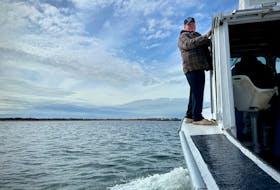Tom Duffy
Guest Opinion
Earlier this month, Atlantic Canadians experienced one of the strongest storms to hit the region in recent memory.
Hurricane Dorian made landfall in Nova Scotia as a hurricane-strength post-tropical storm with winds whipping at more than 100 kilometres per hour.
Waves wreaked havoc on the shoreline, tearing up wharfs, breakwaters and flooding people’s homes. Campers hunkered down at P.E.I’s Crystal Beach Campground had to be rescued by first-responders when the tide rushed in suddenly, trapping them inside their trailers.
The problem in Atlantic Canada is two-fold: Rising global temperatures are melting glaciers and sea ice, pouring an excess of water into Earth’s oceans. And this is being exacerbated by the fact that our region’s landmass is also slowly sinking.
Sea levels have already risen an average of 19 centimetres globally, with 75 per cent of that rise taking place in just the last 40 years.
And scientists are predicting that by 2100, they’ll rise at least a metre in Atlantic Canada — that’s even higher than the Canadian global average.
The water is coming whether we believe it or not. That’s why it’s time to start planning, and using natural solutions for coastal flooding and sea-level rise, especially wetlands like coastal salt marshes.
These work-horse wetlands are natural buffers against rising tides and stormy seas and extremely effective at protecting the coast from erosion and flooding. As tides bring in sand and soils from offshore, it settles in between the roots and stalks of marsh grasses and form a kind of fortification against the waves.
Unfortunately, many of these important ecosystems have disappeared across the region. Since the early 1700s, more than half of Nova Scotia’s coastal marshes have been lost to other land uses, leaving much of our Atlantic coastal communities vulnerable.
DUC looks after thousands of hectares of wetlands near or along Atlantic Canada’s coasts. It was general practice in the 1970s and 1980s to convert former saltmarshes — which had been drained or cut off from the ocean by dykes — to freshwater wetlands.
Waterfowl populations were in decline back then and these restored wetlands became important habitat for species of concern, including American black ducks.
But today, as the ocean eats away at old dykes and salty tides seep into these freshwater marshes, we’re re-evaluating our coastal conservation strategies. The best way to battle rising water, we’ve found, is to embrace it.
That’s why we’ve started restoring coastal marshes across the Maritimes. We’ve let tidewater back into wetlands in places like Kentville, N.S., Musquash, N.B., and Rochford Pond in P.E.I. The transformation of these projects to saltmarsh have been striking.
Here, coastal plants like spartina, sea blight, and seaside goldenrod are flourishing, helping to create important habitat for wildlife, but also fortifying that natural coastal barrier against higher tides, stronger storms, and rising seas.
As we prepare across the region for more intense storms like Hurricane Dorian, we need to ask: how do we adapt to this new reality?
We’ve got to think creatively, implement coastal protection policies for what natural shoreline we have left, and restore what we’ve lost.
The ocean is rising. Building sea walls and dykes higher is not going to stop it.
We already have solutions, we just need to get out of the way and let wetlands do their work.
Tom Duffy is the manager of provincial operations, Atlantic region for Ducks Unlimited Canada.








